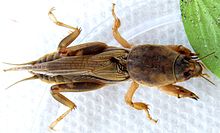Scapteriscus
| Scapteriscus | |
|---|---|

| |
| Scapteriscus vicinus | |
| Scientific classification | |
| Domain: | Eukaryota |
| Kingdom: | Animalia |
| Phylum: | Arthropoda |
| Class: | Insecta |
| Order: | Orthoptera |
| Suborder: | Ensifera |
| Family: | Gryllotalpidae |
| Subfamily: | Scapteriscinae |
| Tribe: | Scapteriscini |
| Genus: | Scapteriscus Scudder, 1869 |
| Species | |
|
see text | |
Scapteriscus is a genus of insects in the family Gryllotalpidae, the mole crickets. Members of the genus are called two-clawed mole crickets.[1] They are native to South America.[2] Some species have arrived in other regions (by flight or as contaminants of ship ballast or cargoes), including parts of North America, where some have become invasive and have become established as pests.[1]
Description[edit]
These are medium-sized or large mole crickets characterized by the structures on their forelegs: two sharp claws and a blade-like process with a sharp flange or tooth. Other mole crickets have three or four claws.[3] Like other mole crickets, these burrow in the ground and the males produce calls with their tegmina.[4]
Impacts[edit]
Scapteriscus species have been called "the most damaging crickets in the New World".[1] The major pest species include S. abbreviatus, S. borellii, S. didactylus, and S. vicinus.[5] These burrowing insects are pests of lawns, pastures, and gardens.[1] Some species feed on plant roots and seedlings,[6] while others are carnivorous and damage turf with their digging activity.[7] They are notorious in the Southeastern United States, where they have been called "the most damaging insect pests of turf and pasture grasses in Florida".[2] S. didactylus is invasive in Australia, where it damages turf, especially on golf courses, and attacks crops such as rice and peppers.[8]
In French Guiana, S. didactylus is a predator of the eggs of the critically endangered leatherback sea turtle (Dermochelys coriacea).[9]
Agents of biological pest control have proved effective for these mole crickets.[10] The nematode Steinernema scapterisci kills the mole cricket by carrying bacteria into its body, introducing an overwhelming infection.[1][11] The tachinid fly Ormia depleta is a parasitoid that leaves its carnivorous larva on the body of the mole cricket[12][13] The crabronid wasp Larra bicolor (family Crabronidae) catches the mole cricket and sticks an egg to it. When the larva emerges, it consumes the mole cricket alive.[14][1]
Diversity[edit]
In 2003, 21 species were in the genus.[4] More have since been described.[3]
- Scapteriscus abbreviatus – short-winged mole cricket
- Scapteriscus borellii – southern mole cricket
- Scapteriscus cerberus[3]
- Scapteriscus costaricensis
- Scapteriscus didactyloides
- Scapteriscus didactylus – West Indian mole cricket, changa
- Scapteriscus ecuadorensis
- Scapteriscus grossi
- Scapteriscus imitatus – imitator mole cricket
- Scapteriscus macrocellus
- Scapteriscus peruvianus
- Scapteriscus quadripunctatus
- Scapteriscus saileri
- Scapteriscus tenuis
- Scapteriscus vicinus – tawny mole cricket
- Scapteriscus zeuneri[3]
Two species of Scapteriscus were separated and placed in the new genus Indioscaptor.[4]
References[edit]
- ^ a b c d e f Genus Scapteriscus. In: Walker, T. J. Singing Insects of North America. Entomology and Nematology. University of Florida, IFAS.
- ^ a b Parkman, J. P. and J. H. Frank. (1992). Infection of sound-trapped mole crickets, Scapteriscus spp., by Steinernema scapterisci. Florida Entomologist 75(1) 163-65.
- ^ a b c d Rodríguez, F. and S. Heads. (2012). New mole crickets of the genus Scapteriscus Scudder from Colombia (Orthoptera: Gryllotalpidae; Scapteriscinae). Zootaxa 3282, 61–68.
- ^ a b c d Nickle, D. A. (2003). A revision of the mole cricket genus Scapteriscus with the description of a morphologically similar new genus (Orthoptera: Gryllotalpidae: Scapteriscinae). Transactions of the American Entomological Society 129(3–4) 411–485.
- ^ a b Names, Origins, and Distribution of Mole Crickets. Entomology and Nematology. University of Florida, IFAS.
- ^ Tawny Mole Cricket, S. vicinus. Entomology and Nematology. University of Florida, IFAS.
- ^ Southern Mole Cricket, S. borellii. Entomology and Nematology. University of Florida, IFAS.
- ^ Rentz, D. C. F. (1995). The changa mole cricket, Scapteriscus didactylus (Latreille), a New World pest established in Australia (Orthoptera: Gryllotalpidae). Australian Journal of Entomology 34(4) 303-06.
- ^ Maros, A., et al. (2003). Scapteriscus didactylus (Orthoptera, Gryllotalpidae), predator of leatherback turtle eggs in French Guiana. Marine Ecology Progress Series 249,289-96.
- ^ Frank, J. H. and Walker, T. J. (2006) Permanent control of pest mole crickets (Orthoptera: Gryllotalpidae: Scapteriscus) in Florida. American Entomologist 52: 138-144 [1]
- ^ Smart, G. C. (1994). Steinernema scapterisci, a nematode parasite of mole crickets, Scapteriscus spp. Nematology Circular No. 206. Florida Department of Agriculture and Consumer Services.
- ^ Frank, J.H., Walker, T.J., Parkman, J.P. 1996. The introduction, establishment and spread of Ormia depleta in Florida. Biological Control 6: 368-377.
- ^ Walker, T.J., Parkman, J.P., Frank, J.H., Schuster, D.J. 1996. Seasonality of Ormia depleta and limits to its spread. Biological Control 6: 378-383.
- ^ Frank, J.H. and Sourakov, A. 2012. Larra wasps, mole cricket hunters. http://entnem.ifas.ufl.edu/creatures/beneficial/Larra_wasps.htm
